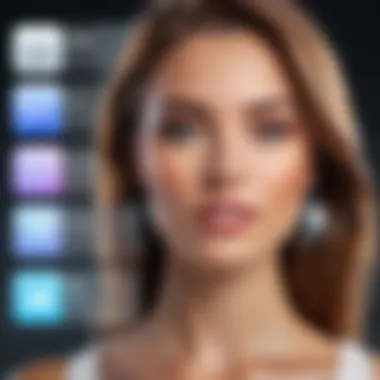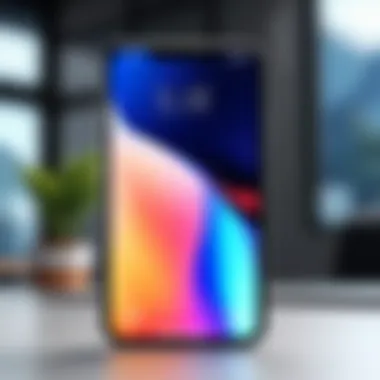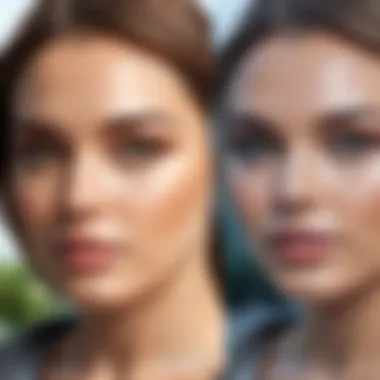Mastering Image Blur on iPhone: Techniques & Tips


Intro
In the age of digital communication, the importance of privacy and aesthetics has never been more pronounced. As consumers increasingly share images online, there arises a need to obscure sensitive information or simply enhance the visual appeal of photographs. This raises the question: how can iPhone users effectively blur out pictures? This article serves as a comprehensive guide tailored for the tech-savvy individuals seeking to leverage both built-in features and third-party applications to achieve that effect.
By exploring the various methods available on iPhone, readers will gain insights into how to manipulate images to their advantage. It is essential to understand the functionality of iPhone’s editing tools, as well as the myriad of apps dedicated to image modification. This knowledge empowers users to make informed choices about their photos, whether for the sake of privacy or artistic expression.
The following sections will delve into the technology behind iPhone photo editing capabilities, discussing their specifications and unique features, followed by a look at the usability of popular apps for blurring images. By synthesizing this information, the article aims to equip readers with the necessary skills to obscure elements in their pictures effectively.
Prologue to Image Blurring
In an age where images are ubiquitous, the ability to manipulate them holds significant value. Blurring images is not merely an artistic indulgence; it serves multiple purposes that are increasingly relevant in today’s digital landscape. The introductory section will delve into essential elements of image blurring, emphasizing its benefits and some important considerations.
Understanding Image Blurring
Image blurring involves reducing the sharpness of certain elements within a photograph. This can be achieved through various techniques, such as applying a Gaussian blur effect. The primary aim is to create a softer focus around the subject, making it less prominent in the overall composition. Blurring can also be used to enhance the aesthetic appeal of an image.
By understanding the mechanics behind image blurring, users can make informed choices when editing their photos. For example, knowing how different types of blur affect the overall visual impact can inform creative decisions. The science of blurring also illustrates how depth and focus relate to perception, which is essential for any photography enthusiast.
Reasons for Blurring Photos
There are several reasons that individuals might choose to blur parts of an image. They range from practical applications to aesthetic enhancements:
- Enhancing Privacy: One of the most common reasons for blurring images is to protect the identities of people in photos. This is particularly significant when posting images on social media platforms where personal information can be inadvertently exposed. A blurred face can conceal someone’s identity without completely removing them from the context.
- Focusing Attention: Blurring distractions in a photo can lead the viewer’s attention to the main subject. For instance, a beautifully composed shot of a landscape might include clear skies but distracting elements in the foreground. By applying a blur, those elements can fade into the background, allowing the central subject to shine.
- Artistic Effects: Some photographers and content creators use blurring as a stylistic choice. This technique can evoke emotions, create a particular mood, or even bring a dreamlike quality to the image. In social media marketing, unique visual styles can enhance brand identity and audience engagement.
Blurring is foundational not just for personal privacy, but as a tool for creative expression. Understanding its applications can enhance how we perceive and share images in our digital lives.
Built-in iPhone Photo Editing Features
In the context of this guide, the built-in photo editing features on the iPhone serve as essential tools for users looking to blur images effectively. With these incorporated capabilities, users do not need to rely solely on third-party applications for common image adjustments. The significance of these features includes ease of access, familiar interface, and sufficient functionality for most everyday photo-editing needs.
Using the Photos App
The Photos app is central to this functionality. It acts as the primary hub for managing all images and videos on the iPhone. This app is integral in facilitating users to quickly edit images without the need for additional installations. The key characteristic here is the seamless integration within iOS, fostering a user-friendly environment.
Accessing the Photos App
Accessing the Photos app is straightforward. Users simply tap on the app icon, and they are presented with their entire library of images. This is a popular choice because it is pre-installed on all iPhones. The unique feature of the Photos app is its streamlined organization of images and albums, which makes finding specific photos efficient. There are virtually no disadvantages to accessing this app as it is available on every device.
Selecting the Image to Edit


Selecting the image is a crucial step in the editing process. Users can scroll through their photo library and tap on the photo they wish to modify. The simplicity of this action contributes significantly to the overall goal of quick and effective editing. This choice is beneficial because users can see image previews clearly. The unique feature is the ability to easily view date and location metadata. One disadvantage could be the reliance on visual browsing, which might be cumbersome for users with extensive photo collections.
Applying Blur Effects
Applying blur effects is a significant part of the editing capabilities. Once the user selects an image, they can choose from various editing tools, including the adjustment of focus and blur. This feature is popular because it allows for immediate visual feedback during the editing process. The unique aspect of applying blur effects within the Photos app is the capacity to adjust the level of blur to fit one's preferences. There are few disadvantages, but a lack of advanced options might limit professional users seeking more detailed controls.
Adjusting Image Focus
Adjusting image focus is another important feature of the built-in editing tools. It allows users to refine which areas of an image remain sharp while deciding what should be blurred. This focus control enriches the editing experience by providing a balance between clarity and obscurity. It offers a beneficial option for making images look more professional with simple adjustments.
Understanding Depth Control
Depth control enhances editing by allowing users to manipulate depth of field in their images. This feature is crucial as it provides the ability to create a dimensional effect, where subjects are more pronounced against blurred backgrounds. This characteristic is especially useful for portraiture, as it draws attention to the subject. The depth control feature's unique aspect is the intuitive slider that adjusts the focus, making it accessible. One drawback is that it may not function as effectively in all lighting conditions.
Using Portrait Mode for Blurs
Utilizing Portrait mode for blurs can enhance photo quality significantly. This mode is designed specifically for blurring backgrounds while keeping the main subject in focus. This feature stands out because it captures depth in a way that is typically seen in higher-end cameras. However, the uniqueness of Portrait mode can come with limitations, such as requiring a certain amount of light and a specific distance from the subject to function correctly.
"Mastering the built-in features of the Photos app can significantly enhance your iPhone photography without the need for additional software."
Overall, understanding and utilizing the built-in photo editing features on the iPhone can equip users with the necessary tools to blur images effectively, enhancing both privacy and aesthetic appeal.
Third-Party Apps for Blurring Photos
Third-party apps are essential tools that can enhance your photo editing experience on the iPhone. Unlike the built-in features of the Photos app, these apps provide a wide array of options specifically designed for blurring images. They allow more control and fine-tuning, which is critical for users seeking precise edits. Moreover, these applications often come equipped with advanced features that cater to various needs, from basic image blurring to intricate effects.
Using third-party apps can also be convenient. Users can find tailored functionalities that suit their creative direction, leading to better results overall. People seeking privacy, for instance, might find it extremely useful to blur faces in their photos without affecting the overall quality of the image.
Overview of Popular Editing Apps
More and more users are turning towards popular apps like Snapseed and AfterFocus for image blurring. Each app serves different levels of editing proficiency while offering distinct features.
- Snapseed is well-known for its user-friendly interface and powerful editing tools, making it accessible for beginners yet robust enough for advanced users. Its selective blur tool allows for creative variations in blurring.
- AfterFocus, on the other hand, focuses on creating realistic blur effects by allowing users to select specific areas to blur. This provides an added level of depth and control.
Both apps have their unique advantages and cater to different audience segments. Moreover, they frequently update, ensuring that users have access to the latest features and improvements in user experience.
Using Snapseed for Blurring
Downloading Snapseed
Downloading Snapseed is straightforward, as the app is available for free on the App Store. Its easy access encourages iPhone users to explore its functionalities. After downloading, users gain immediate entry to a powerful tool.


One key characteristic of Snapseed is its versatility. It is not just limited to blurring; it includes features for enhancing overall image quality. This multifunctionality makes it a worthwhile investment for any user.
Steps to Blur Images
To blur images using Snapseed, the steps are simple. Start by opening the image you want to edit, selecting the 'Tools' menu, and then choosing the 'Lens Blur' option. Users can adjust the blur strength and the focus area to achieve optimal results. This ease of use is one of Snapseed's greatest advantages, especially for users not familiar with complex editing interfaces.
Ultimately, Snapseed provides an efficient and user-friendly way to blur images. Its accessibility does not compromise the depth of tools it offers.
Saving and Sharing Edited Images
Once you have completed editing, saving and sharing your newly blurred images is easy with Snapseed. You can export your photos directly to your camera roll or share them on social media platforms right from the app. This integration of sharing features simplifies the workflow and encourages quick distribution.
One standout feature is the ability to save edits without reformatting the original image. This makes it an appealing choice for iPhone users who wish to maintain a pristine version of their files.
Utilizing AfterFocus for Advanced Options
Installing AfterFocus
Installing AfterFocus is also a simple process that can be done via the App Store. This app is particularly useful for users looking for more advanced blurring options.
A notable feature is its capability to create bokeh effects that mimic the outcomes seen in professional photography. This artistic touch allows users to refine their images creatively while clearly highlighting focus areas.
Selectively Blurring with Lenses
AfterFocus shines in its ability to selectively blur parts of an image using lenses. This selective focus method enhances the visual storytelling in users' photos. It allows for a greater emphasis on subjects by adjusting the depth of field.
Such features are valuable for users wanting a nuanced approach to their photo editing needs. By using different lens options, they can create beautiful distinctions between foreground and background elements.
Exporting in High Resolution
One of the most appreciated aspects of AfterFocus is its option for exporting images in high resolution. This is vital for anyone looking to maintain quality, especially for prints or professional use. The high-resolution output ensures that the blurred effects retain clarity and integrity.
Overall, AfterFocus provides sufficient creative options that cater to both casual and serious photographers. Users will find it enhances their photos effectively without intricate procedures.
Practical Applications of Blurring
Blurring images on an iPhone goes beyond mere aesthetics. It serves a purpose in protecting privacy, enhancing visuals, and navigating legal landscapes. Understanding practical applications can help users make the most of their editing capabilities.
Enhancing Privacy in Shared Images


Reasons for Privacy Concerns
Privacy is a critical issue in this digital age. Many individuals share photos online without considering the implications. Everyday moments captured in images often include other people, whose consent might not be obtained. This raises significant privacy concerns. By blurring out faces or identifying details, one can share images safely. This practice ensures that sensitive content respects individuals’ rights and boundaries. A blurred photo allows storytelling without compromising privacy. Additionally, this feature becomes a beneficial option for a wide audience wanting to engage socially while still being cautious.
Methods to Blur Faces and Identifying Elements
Blurring faces and recognizing features in images addresses privacy concerns effectively. The methods allow specific elements to be obscured while retaining the overall context of the image. Users typically use tools within editing apps that provide selective blurring. This option enables the editing process to focus on critical aspects of a photo, rather than entirely altering the visual content. Utilizing faces and identifiable elements blurs increases choices for photographers or content creators concerned with privacy.
Aesthetic Modifications for Social Media
Creating Eye-Catching Visuals
Many people engage social media to showcase creativity. Blurring images selectively can elevate the visual appeal of photos. Such modifications draw attention to focal points in the image. This technique can be a standout aspect for those wanting unique presentations. Blurs used artistically can create a distinct style. These visuals can enhance social media profiles and improve engagement rates. Users prefer this method because it serves both functional and aesthetic purposes.
Utilizing Blurring for Focus Techniques
Focusing techniques utilize blurring extensively in photography. The contrast of sharp and soft areas leads viewers’ eyes to the most essential parts of the picture. This strategy captures the viewer’s attention where it matters the most, effectively improving the message conveyed through the image. By mastering this function, photographers can better display their subjects while simultaneously crafting an engaging narrative. Harnessing blurring to direct focus is increasingly a go-to method among content creators.
Legal and Ethical Considerations
Copyright Issues
Copyright challenges are common when sharing images. Blurring certain elements may offer a solution. It allows owners of images to protect their creative works while also noting the original intent behind the photography. Individuals often find themselves in disputes if proper permissions are not obtained. Using blurring can safeguard creativity against unauthorized use. Additionally, being aware of these legal complexities makes the process safer for users. This practice of obscuring certain parts can minimize infringement risks.
Respecting Subject Privacy
Respecting subject privacy is paramount. When publishing images online, consideration of the individuals depicted is essential. Blurring provides an avenue for this respect. It signals awareness of privacy needs while navigating online sharing practices. By incorporating blurs in photos, individuals show they treat subjects with care. This approach guards against potential conflicts and fosters a culture of respect in digital communications. Balancing aesthetics with ethical considerations solidifies the value attributed to image sharing.
Blurring images not only improves aesthetics but significantly enhances privacy and addresses legal challenges.
Finale
The conclusion of this guide highlights the various techniques for blurring images on an iPhone, showcasing an essential tool for users aiming to protect their privacy or enhance the aesthetics of their photographs. Understanding the methods and applications of image blurring not only serves practical needs but also encourages a deeper engagement with digital content.
Recap of Methods and Applications
In this article, we have explored multiple avenues to blur images on an iPhone.
- Built-in Editing Features: The Photos app allows for straightforward image adjustments, including blurring. Users can access basic blur options and play with depth control.
- Third-Party Applications: Apps like Snapseed and AfterFocus offer advanced features to create refined blur effects. These tools provide users with fine control over selective blurring, which is beneficial for both privacy and artistic purposes.
- Practical Applications: Whether it is for enhancing privacy by obscuring identifiable information or crafting appealing imagery for social media, the techniques of blurring serve several causes. Understanding the fine line between protecting privacy and altering visual content is a key takeaway from this guide.
Future Developments in Photo Editing
As technology progresses, photo editing capabilities are likely to become more sophisticated and accessible. Innovations in artificial intelligence may lead to smarter blur tools, allowing for automatic detection of faces or objects to be blurred. This could enhance usability for those less skilled in digital editing. Furthermore, evolving platforms and regular updates to current applications ensure that users will have more options at their disposal. As smartphone cameras improve, the necessity for effective editing tools such as blurring will only continue to grow in importance.
"In the digital age, mastering image editing is as crucial as capturing the perfect photograph."
By adopting these methods and keeping an eye on future advancements in technology, users can stay ahead of trends in photography and digital content. This understanding empowers them to create engaging and safe visual narratives.







